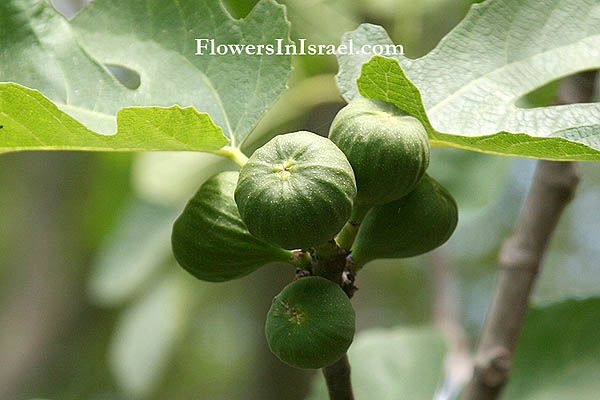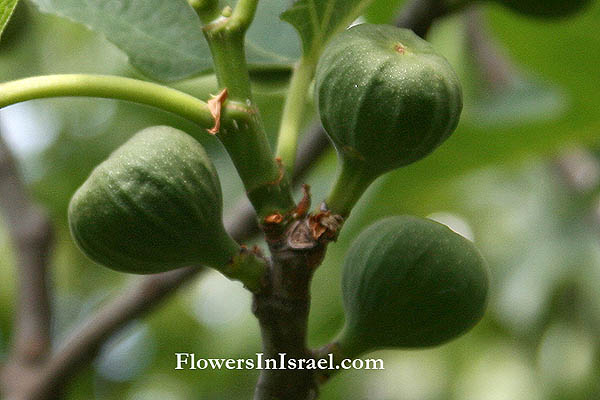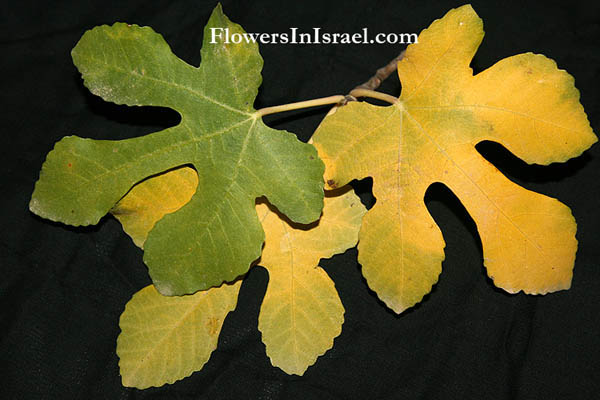
Derivation of the botanical name:
Ficus, Latin for Ficus carica. The Latin words for fig - ficus, fica (and from them the English word "fig"), derive from the Hebrew word pag פג, meaning "unripe fig". Today the word pag refers to a premature infant.
carica of or pertaining to Caria, a Roman province now south west Turkey around Dalaman river, known for its cultivation of figs.
The hebrew word: תאנה, te'ena, te-i-na; the Akkadian name: tittu, tiʾittu; Arabic: تين, tayn.
te-i-na is the Hebrew word for "fig tree." In Hebrew literature the word "fig tree" is synonymous with "prosperity." It was not in Babylonia nor in Assyria that man "dwelt under" and ate "every one of his fig tree," but in Syria (see Mic. 4: 4; Is. 36: 16, etc.)
- The standard author abbreviation L. is used to indicate Carl Linnaeus (1707 – 1778), a Swedish botanist, physician, and zoologist, the father of modern taxonomy.
The first tree to be mentioned by name in the Bible is the fig, in the story of Adam and Eve: "the eyes of them both were opened, and they knew that they were naked; and they sewed fig leaves together, and made themselves aprons" (Genesis 3:7).
The Hebrew word used in this reference is Tĕênâh (Greek, σύκον or συκή), fig tree. The four other words used in the Bible refer to different stages of the fruit:
Tĕênîm, תאנים, (plural form of tĕênâh), תאנה, used in Jeremiah 8:13, indicates figs as fruit.
Pag, פג, (Greek, őλυνθος ), used in Song 2:13, is the green or unripened fruit, which remains on the tree through the winter.
Bikkûrah, בכורה, used in Hosea 9:10, is the “firstripe” or “early fig”.
Debelah, דבלה, used in I Samuel 25:18, II Kings 20:7, is a cake of dried figs, the main produce of the tree kept for winter use.
The Ficus carica was cultivated for its fruit some 6500 years ago.
It is a dioecious species with separate male and female trees, and a symbiotic pollinator wasp (Blastophaga psenes) that is propagated inside the fruits (syconia) of male trees called capri figs.
Pollination of edible figs requires fig wasps to transport pollen from Capri fig flowers.
The Ficus carica is native to the region between the Mediterranean and Black Seas.
Evidently many ancient civilizations were aware of the fact that Ficus carica required pollination in order to produce edible, seed-bearing fruits, a process called caprification.
- Aristotle (384-322 BCE) described fig wasps that came out of Capri figs and penetrated the unripe female fig fruits, thus fertilizing them.
- Theophrastus of Eresos (371-287 BCE) was essentially the first botanical taxonomist and some 2,300 years ago he described in details on fig caprification.
In order to prevent the abortion of their embryo cultivar figs, the farmers arranged that ripe wild figs were hung in orchards of the cultivars at embryo stage, or even went so far as to interplant the early, intermediate and late cultivars (you get three crops per annum in the Mediterranean) with the appropriate wild variety.
They were aware of the galls which develop in the inedible or goat-fig and were aware of the insect which came out of the ripe fruit and entered the embryo fruit, allowing it to develop to an edible fig.
The flower of a fig of course, is very unusual in that it is completely enclosed within the fig itself and never seen, male flowers at the top and female below. It is fertilised by a tiny wasp which leaves the ripe fig and enters the embryo fig via a minute hole at the top, which is hidden by overlapping scales.
Each species of fig has developed a symbiosis with a different wasp over the last 100 million years.
- Plato (427 BCE-347 BCE), called figs a food for athletes. The Greeks were well aware of the fig’s value and forbade its export in order to protect Attica’s main resource, "more precious than gold."
- Pliny (23–79 CE), states that homegrown Figs formed a large portion of the food of slaves, especially in the fresh state for agricultural workers.
- Dioscorides (40 – 90 CE), a Greek physician who traveled as a surgeon with the armies of the Roman emperor Nero, compiled De Materia Medica around 77 CE.
De Materia Medica was the foremost classical source of modern botanical terminology and the leading pharmacological text until the 15th century.
He stated how milk clotted with the sap of the fig tree. Fig juice made milk coagulate in the manner of rennet.
See the list of Medicinal herbs in Israel, the parts used and their medical uses to treat various diseases.
See: Tu Bishvat (ט"ו בשבט), "The New Year For the Trees"
Bible resources:
- Genesis 3:7
Then the eyes of both of them were opened, and they realized they were naked; so they sewed fig leaves together and made coverings for themselves.
- Numbers 13:23
When they reached the Valley of Eshkol, they cut off a branch bearing a single cluster of grapes. Two of them carried it on a pole between them, along with some pomegranates and figs.
- Numbers 20:5
Why did you bring us up out of Egypt to this terrible place? It has no grain or figs, grapevines or pomegranates. And there is no water to drink!”
- Deuteronomy 8:8
a land with wheat and barley, vines and fig trees, pomegranates, olive oil and honey;
- Judges 9:10
“Next, the trees said to the fig tree, ‘Come and be our king.’
- Judges 9:11
“But the fig tree replied, ‘Should I give up my fruit, so good and sweet, to hold sway over the trees?’
- 1 Samuel 25:18
Abigail acted quickly. She took two hundred loaves of bread, two skins of wine, five dressed sheep, five seahs of roasted grain, a hundred cakes of raisins and two hundred cakes of pressed figs, and loaded them on donkeys.
- 1 Samuel 30:12
part of a cake of pressed figs and two cakes of raisins. He ate and was revived, for he had not eaten any food or drunk any water for three days and three nights.
- 2 Samuel 16:1
[ David and Ziba ] When David had gone a short distance beyond the summit, there was Ziba, the steward of Mephibosheth, waiting to meet him. He had a string of donkeys saddled and loaded with two hundred loaves of bread, a hundred cakes of raisins, a hundred cakes of figs and a skin of wine.
- 1 Kings 4:25
During Solomon’s lifetime Judah and Israel, from Dan to Beersheba, lived in safety, everyone under their own vine and under their own fig tree.
- 2 Kings 18:31
“Do not listen to Hezekiah. This is what the king of Assyria says: Make peace with me and come out to me. Then each of you will eat fruit from your own vine and fig tree and drink water from your own cistern,
- 1 Chronicles 12:40
Also, their neighbors from as far away as Issachar, Zebulun and Naphtali came bringing food on donkeys, camels, mules and oxen. There were plentiful supplies of flour, fig cakes, raisin cakes, wine, olive oil, cattle and sheep, for there was joy in Israel.
- 2 Kings 20:7
Then Isaiah said, “Prepare a poultice of figs.” They did so and applied it to the boil, and he recovered.
- 1 Chronicles 12:40
Also, their neighbors from as far away as Issachar, Zebulun and Naphtali came bringing food on donkeys, camels, mules and oxen. There were plentiful supplies of flour, fig cakes, raisin cakes, wine, olive oil, cattle and sheep, for there was joy in Israel.
- Psalm 105:33
he struck down their vines and fig trees and shattered the trees of their country.
- Proverbs 27:18
The one who guards a fig tree will eat its fruit, and whoever protects their master will be honored.
- Song of Songs 2:13
The fig tree forms its early fruit; the blossoming vines spread their fragrance. Arise, come, my darling; my beautiful one, come with me.”
- Isaiah 9:10
“The bricks have fallen down, but we will rebuild with dressed stone; the fig trees have been felled, but we will replace them with cedars.”
Isaiah 28:4
That fading flower, his glorious beauty, set on the head of a fertile valley, will be like figs ripe before harvest— as soon as people see them and take them in hand, they swallow them.
- Isaiah 34:4
All the stars in the sky will be dissolved and the heavens rolled up like a scroll; all the starry host will fall like withered leaves from the vine, like shriveled figs from the fig tree.
- Isaiah 36:16
“Do not listen to Hezekiah. This is what the king of Assyria says: Make peace with me and come out to me. Then each of you will eat fruit from your own vine and fig tree and drink water from your own cistern,
- Isaiah 38:21
Isaiah had said, “Prepare a poultice of figs and apply it to the boil, and he will recover.”
- Jeremiah 5:17
They will devour your harvests and food, devour your sons and daughters; they will devour your flocks and herds, devour your vines and fig trees. With the sword they will destroy the fortified cities in which you trust.
J - Jeremiah 8:13
“‘I will take away their harvest, declares the Lord. There will be no grapes on the vine. There will be no figs on the tree, and their leaves will wither. What I have given them will be taken from them.’”
- Jeremiah 24:1
[ Two Baskets of Figs ] After Jehoiachin son of Jehoiakim king of Judah and the officials, the skilled workers and the artisans of Judah were carried into exile from Jerusalem to Babylon by Nebuchadnezzar king of Babylon, the Lord showed me two baskets of figs placed in front of the temple of the Lord.
- Jeremiah 24:2
One basket had very good figs, like those that ripen early; the other basket had very bad figs, so bad they could not be eaten.
- Jeremiah 24:3
Then the Lord asked me, “What do you see, Jeremiah?” “Figs,” I answered. “The good ones are very good, but the bad ones are so bad they cannot be eaten.”
- Jeremiah 24:5
“This is what the Lord, the God of Israel, says: ‘Like these good figs, I regard as good the exiles from Judah, whom I sent away from this place to the land of the Babylonians.
- Jeremiah 24:8
“‘But like the bad figs, which are so bad they cannot be eaten,’ says the Lord, ‘so will I deal with Zedekiah king of Judah, his officials and the survivors from Jerusalem, whether they remain in this land or live in Egypt.
- Jeremiah 29:17
yes, this is what the Lord Almighty says: “I will send the sword, famine and plague against them and I will make them like figs that are so bad they cannot be eaten.
- Hosea 2:12
I will ruin her vines and her fig trees, which she said were her pay from her lovers; I will make them a thicket, and wild animals will devour them.
- Hosea 9:10
“When I found Israel, it was like finding grapes in the desert; when I saw your ancestors, it was like seeing the early fruit on the fig tree. But when they came to Baal Peor, they consecrated themselves to that shameful idol and became as vile as the thing they loved.
- Joel 1:7
It has laid waste my vines and ruined my fig trees. It has stripped off their bark and thrown it away, leaving their branches white.
- Joel 1:12
The vine is dried up and the fig tree is withered; the pomegranate, the palm and the apple tree— all the trees of the field—are dried up. Surely the people’s joy is withered away.
- Joel 2:22
Do not be afraid, you wild animals, for the pastures in the wilderness are becoming green. The trees are bearing their fruit; the fig tree and the vine yield their riches.
- Amos 4:9
“Many times I struck your gardens and vineyards, destroying them with blight and mildew. Locusts devoured your fig and olive trees, yet you have not returned to me,” declares the Lord.
- Micah 4:4
Everyone will sit under their own vine and under their own fig tree, and no one will make them afraid, for the Lord Almighty has spoken.
- Micah 7:1
[ Israel’s Misery ] What misery is mine! I am like one who gathers summer fruit at the gleaning of the vineyard; there is no cluster of grapes to eat, none of the early figs that I crave.
- Nahum 3:12
All your fortresses are like fig trees with their first ripe fruit; when they are shaken, the figs fall into the mouth of the eater.
- Habakkuk 3:17
Though the fig tree does not bud and there are no grapes on the vines, though the olive crop fails and the fields produce no food, though there are no sheep in the pen and no cattle in the stalls,
- Haggai 2:19
Is there yet any seed left in the barn? Until now, the vine and the fig tree, the pomegranate and the olive tree have not borne fruit. “‘From this day on I will bless you.’”
- Zechariah 3:10
“‘In that day each of you will invite your neighbor to sit under your vine and fig tree,’ declares the Lord Almighty.”
- Matthew 7:16
By their fruit you will recognize them. Do people pick grapes from thornbushes, or figs from thistles?
- Matthew 21:19
Seeing a fig tree by the road, he went up to it but found nothing on it except leaves. Then he said to it, “May you never bear fruit again!” Immediately the tree withered.
- Matthew 21:20
When the disciples saw this, they were amazed. “How did the fig tree wither so quickly?” they asked.
- Matthew 21:21
Jesus replied, “Truly I tell you, if you have faith and do not doubt, not only can you do what was done to the fig tree, but also you can say to this mountain, ‘Go, throw yourself into the sea,’ and it will be done.
- Matthew 24:32
“Now learn this lesson from the fig tree: As soon as its twigs get tender and its leaves come out, you know that summer is near.
- Mark 11:12
[ Jesus Curses a Fig Tree and Clears the Temple Courts ] The next day as they were leaving Bethany, Jesus was hungry.
- Mark 11:13
Seeing in the distance a fig tree in leaf, he went to find out if it had any fruit. When he reached it, he found nothing but leaves, because it was not the season for figs.
- Mark 11:20
In the morning, as they went along, they saw the fig tree withered from the roots.
- Mark 11:21
Peter remembered and said to Jesus, “Rabbi, look! The fig tree you cursed has withered!”
- Mark 13:28
“Now learn this lesson from the fig tree: As soon as its twigs get tender and its leaves come out, you know that summer is near.
- Luke 6:44
Each tree is recognized by its own fruit. People do not pick figs from thornbushes, or grapes from briers.
- Luke 13:6
Then he told this parable: “A man had a fig tree growing in his vineyard, and he went to look for fruit on it but did not find any.
- Luke 13:7
So he said to the man who took care of the vineyard, ‘For three years now I’ve been coming to look for fruit on this fig tree and haven’t found any. Cut it down! Why should it use up the soil?’
- Luke 21:29
He told them this parable: “Look at the fig tree and all the trees.
- John 1:48
“How do you know me?” Nathanael asked. Jesus answered, “I saw you while you were still under the fig tree before Philip called you.”
- John 1:50
Jesus said, “You believe because I told you I saw you under the fig tree. You will see greater things than that.”
- James 3:12
My brothers and sisters, can a fig tree bear olives, or a grapevine bear figs? Neither can a salt spring produce fresh water.
- Revelation 6:13
and the stars in the sky fell to earth, as figs drop from a fig tree when shaken by a strong wind.
QURANIC REFERENCES:
- ‘By the fig, and by the olive! By Mount Sinai, and by this inviolate city.
We created man in a most noble image and in the end we shall reduce
him to the lowest of the low: except the believers who do good works,
for theirs shall be a boundless recompense. What after this can make
you the last judgement? Is God not the best of judges?’
Sura 95: 1-8

|


